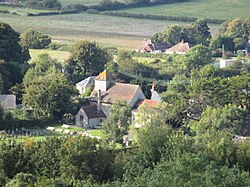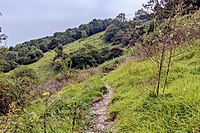Clayton, Sussex
| Clayton | |
| Sussex | |
|---|---|
 Church of St. John the Baptist | |
| Location | |
| Grid reference: | TQ300139 |
| Location: | 50°54’37"N, 0°9’6"W |
| Data | |
| Post town: | Hassocks |
| Postcode: | BN6 |
| Dialling code: | 01273 |
| Local Government | |
| Council: | Mid Sussex |
| Parliamentary constituency: |
Arundel and South Downs |
Clayton is a small village at the foot of the South Downs in the parish of Hassocks, Sussex. It is to be found six miles north of Brighton, and 28 miles east of the county town, Chichester. Other nearby towns include Burgess Hill to the north and Lewes to the east. The Clayton Windmills, known as "Jack and Jill", sit on the hill above the village.
The village gives its name to the nearby Clayton railway tunnel on the Brighton Main Line.
Parish church

- Main article: St John the Baptist's Church, Clayton
The little parish church of St John the Baptist is an Anglo-Saxon church that has a squat bell turret of shingles with a wrought iron weather vane dated 1781.
The church has some magnificent murals, for example the Last Judgement, from the mid-12th century (1150–1200). These murals, unique in England for their date and extent, were first brought to light during repair work in 1893 and were probably painted by artists from St Pancras Priory in Lewes.
Sir Norman Hartnell, who designed Queen Elizabeth II's wedding gown and coronation dress and served as couturier to Elizabeth II (and previously to Queen Elizabeth The Queen Mother, is buried in the churchyard.
History
The London to Brighton Way, a Roman road, is thought to have passed close to Clayton as it climbed the South Downs escarpment.
New Road between Ditchling and Clayton (part of the B2112) was a branch of the turnpike road from Newchapel (in Surrey) to Brighton, via Ditchling. It was authorised by an Act of Parliament passed in 1830:
Clayton Down

On the south side of the village, begin the Downs and the Clayton to Offham Escarpment Site of Special Scientific Interest, which stretches east almost as far as Lewes. The scarp slope below Clayton's windmills (TQ305136) and as far east as Clayton Holt, has been described by David Bangs, a Sussex field naturalist, as "one of nature's self-grown orchards".[1]
Few sites on this part of the Downs can match its richness. There are blackberries, crab apple, four species of Rose, including the apple-scented sweet briar. There are also sloe berries, pink and orange spindle berries and buckthorn. There may be as many at least twenty-five scrub species, eighteen of which have fleshy and colourful fruits and eleven of which of are members of the rose family. Robin's pincushion can be seen on the roses and dogwood.
Clayton Holt
On the scarp is Clayton Holt (TQ310134), a downland wood with at least thirteen ancient woodland indicator species, including two big hybrid large-leaved/ small-leaved limes growing at the base of slope. Up until 1838 there was a large-leaved lime there, a true relic of past forests.[2] The wood is also one of the best places on the Sussex Downs to see veteran beeches. The lesser butterfly orchid, which is much rarer than its cousin the greater butterfly, has also been found there. Fungi are mostly found along the base of slope or on the rotting trunks of fallen beech. Under the beech there are several earthstar fungi.
Recreation
For the size of village there is a large recreation ground located at the west end of the village with a village hall, children's play area and two football pitches.
Pictures
| ("Wikimedia Commons" has material about Clayton, Sussex) |
-
Clayton village
-
Village hall.
-
Church interior
-
Norman Hartnell's grave
References
- ↑ Bangs, Dave (2008). A freedom to roam Guide to the Brighton Downs : from Shoreham to Newhaven and Beeding to Lewes. Brighton: David Bangs. ISBN 978-0-9548638-1-4. OCLC 701098669. https://www.worldcat.org/oclc/701098669.
- ↑ Abraham, Frances and Rose, Francis (Dec 2000) Large-leaved Limes on the South Downs, British Wildlife, Vol. 12, No. 2, page 87.




